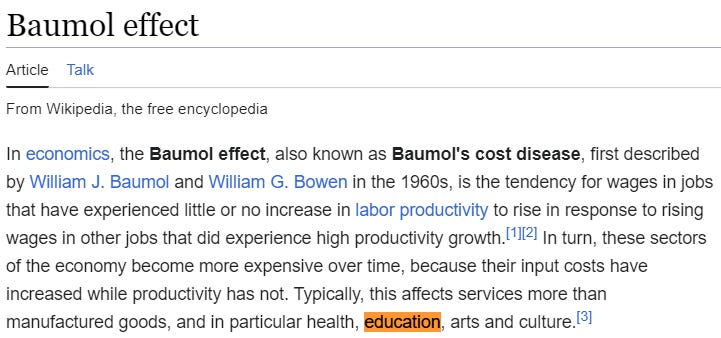Waiting for Baumol
Has the fraction of money spent on wages increased at liberal arts colleges overall, and in instruction specifically? Well let's see.
Last week, I talked about the four main reasons people think college has gotten so expensive. When I plugged the post on Twitter,1 I ran a little poll. Turns out economists (or at least my followers) really think that rising costs are due to increasing labor expenses.
In my previous post I picked at these four hypotheses by showing a bunch of charts about how college’s categorize their expenditures into Instruction, Research, Institutional Support, etc. Those charts showed that the fraction of money colleges spend on each category hasn’t changed much over the last 20 years. To me that headline fact suggests that executive pay (categorized in Institutional Support) or Baumol’s Cost Disease (rising labor costs in activities that haven’t experienced productivity gains, like Instruction) can’t be the main reasons why college has gotten so expensive.
But we can go further. Let’s check out the wage bills directly. Within each of those categories, colleges also report what fraction they spent on wages versus everything else. Who knows, maybe expenditures could be balanced across categories while wages within each category are taking over. Baumol could still live! Let’s check it out.
This chart shows overall spending on wages versus everything else, for the top 100 liberal arts colleges over the last 20 years. Sure does not look to me like wages are taking over college expenses.
We can also break it down by category. Baumol’s cost disease is hypothesized to most affect activities that employ a lot of people who can’t become more productive over time, like for example professors who teach at liberal arts colleges with classes capped at 25 students. Education is literally a primary example of the Baumol effect on Wikipedia.
So how does the wage share of expenditures vary across categories of activities?
This is surprising to me. I would have thought that at least Instruction would experience the Baumol effect! I mean, Wikipedia told me so.
So I went looking for Baumol at a few individual schools. If anywhere were to suffer from the Baumol effect in instruction, it would be Williams College. Williams is the number 1 ranked liberal arts college now and has been for the last 19 years. The professors there produce fantastic research, definitely R1 quality and quantity; Williams is therefore competing in the same labor market as R1 universities and also probably industry, both for new faculty and to retain senior faculty. I’m quite sure they pay well. (Let’s just say that when I hear that a candidate we’ve offered a job to also has an offer from Williams, I politely try to get off the phone as quickly as possible to save myself the time because I know our offer doesn’t stand a chance.) Williams is also kinda in the middle of nowhere. Williamstown, MA has a population just under 8000 people. So I would expect their non-wage expenses (e.g. expenses for space) to be cheaper than for schools in big cities.
Here’s what the wage share of expenditures on instruction looks like at Williams.
What the what? Wages are not taking over! Not even at Williams! If anything they’re falling! WHERE is Baumol?
Contrast that with my alma matter, Reed. I loved Reed. Loved it. Loved my professors, loved my peers, loved Portland Oregon, it was great. As a student. And now as an economist I would not expect them to suffer much from the Baumol effect. Why? Communism.
Reedies like communism so much they put it on their t-shirts. They also have a strictly enforced publicly available salary scale that is dependent on experience and department only. (In order to hire any economists or computer scientists at all, the faculty had to vote to bump just those departments up a few notches [you think your faculty meetings are tense? Imagine that one]). This is exactly the kind of institution that should not experience the Baumol effect, because they’ve pre-committed not to make counter-offers to attractive candidates or people in fields with increasing demand and therefore wages. They’re also in an expensive city, so I would expect their non-wage expenditures to be high. So what does the balance of wage and non-wages expenditures in instruction look like for Reed?
Geez. Reed actually could actually be described as experiencing an increasing wage share in instruction, a.k.a. a bit of Baumol’s effect. (Way to go professor friends! This means you bargained well. Nice faculty organizing! Even after that contentious vote! I am impressed.)
Where does this leave us? Even more confused than last week!
I declare the Baumol’s cost disease hypothesis for rising college costs officially dead. It doesn’t hold up in the aggregate data. We don’t see it at Williams, where we really should. We a tiny bit of it at Reed, where we shouldn’t. The microdata just doesn’t fit the Baumol hypothesis.
But then… what does explain the rising costs?
Subscribe now for more later.
I refuse to call it X. Just, no.












Good post! Looks like I need to stop confidently declaring Cost Disease to be the best reason for college price increase. :-/
This is a super interesting. Can't wait to take these deets to my budget advisory committee meeting...